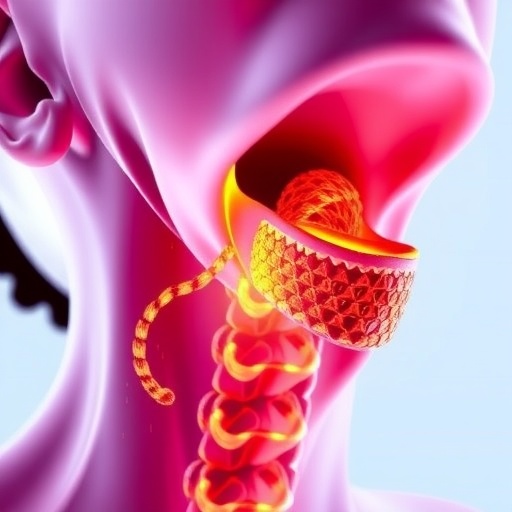In a groundbreaking advance that promises to reshape therapeutic strategies for head and neck squamous cell carcinoma (HNSCC), a recent study has unveiled a novel gene signature associated with FLOT1 that not only predicts clinical outcomes but also illuminates the intricate mechanisms behind tumor radioresistance. This pioneering research, led by Lee, Woo, Noh, and colleagues, delves deep into the molecular underpinnings of one of the most challenging forms of cancer, offering hope for improved patient stratification and tailored treatments.
Head and neck squamous cell carcinoma represents a formidable clinical challenge, notorious for its aggressive behavior and resistance to conventional therapies, particularly radiotherapy. The ability of HNSCC cells to evade destruction by radiation is a major obstacle to successful treatment, often resulting in poor prognoses and high recurrence rates. The study in focus identifies and characterizes the role of the gene FLOT1, and a related gene signature, shedding light on how these molecular players orchestrate radioresistance within the tumor microenvironment.
FLOT1, or flotillin-1, is a membrane-associated protein known to participate in various cellular processes such as endocytosis and signal transduction. Emerging evidence has implicated flotillin proteins in cancer progression, but their exact role has remained obscure until now. The research team’s comprehensive genomic and transcriptomic analyses across multiple patient cohorts revealed that heightened expression of FLOT1 correlates with diminished responsiveness to radiotherapy and worse overall survival.
A distinct gene signature linked to FLOT1, composed of several co-expressed genes involved in cell survival, DNA repair, and apoptosis regulation, was developed to serve as a prognostic tool. This signature accurately stratifies HNSCC patients into high-risk and low-risk categories based on their likelihood of experiencing radioresistant tumor behavior. Notably, patients harboring the high-risk FLOT1 gene signature exhibited significantly shorter progression-free and overall survival times compared to those with low-risk profiles.
Mechanistically, the study elucidated how FLOT1 influences cellular pathways that mitigate the deleterious effects of radiation. Among these, enhanced DNA damage repair capabilities stood out, with FLOT1-positive tumors showing elevated activation of homologous recombination and non-homologous end joining pathways. This molecular resilience enables cancer cells to swiftly rectify radiation-induced DNA double-strand breaks, thereby preserving their viability despite aggressive radiotherapeutic regimens.
Furthermore, the interaction of FLOT1 with the tumor microenvironment was explored, revealing its role in modulating immune evasion and promoting a pro-survival niche. The FLOT1-associated gene signature was found to be intricately linked with immune checkpoint molecule expression and alterations in immune cell infiltration patterns, suggesting a complex interplay that favors radioresistance through inhibition of effective anti-tumor immune responses.
To support these multifaceted findings, the researchers employed advanced bioinformatics, integrating large-scale datasets from The Cancer Genome Atlas (TCGA) and other independent cohorts. This rigorous cross-validation confirmed the robustness of the FLOT1 gene signature as a reliable biomarker across diverse populations and clinical settings. The translational potential of this discovery positions it as a cornerstone for personalized medicine approaches in HNSCC treatment.
In addition to its diagnostic value, the study opens new therapeutic avenues targeting FLOT1 and its downstream effectors. By inhibiting FLOT1-mediated signaling pathways, it may be possible to sensitize tumors to radiation, overcoming resistance and enhancing treatment efficacy. Preclinical experiments conducted with genetic knockdown and pharmacological blockade of FLOT1 demonstrated increased radiosensitivity in HNSCC cell lines, reinforcing the promise of this strategy.
The implications of this research extend into clinical trial design, where the incorporation of the FLOT1 gene signature could refine patient selection for novel treatment regimens, including combinatorial therapies that integrate radiotherapy with molecular inhibitors or immunomodulatory agents. Such precision oncology paradigms are poised to maximize therapeutic benefit while minimizing unnecessary toxicities.
Moreover, understanding the biology behind FLOT1’s role in DNA repair and immune modulation provides fertile ground for scientific inquiry beyond HNSCC. Similar mechanisms may underlie radioresistance in other solid tumors, suggesting that this gene signature might have broader applicability, enhancing the therapeutic landscape across oncology.
The study also underscores the growing importance of integrating multi-omic data to dissect cancer complexity. By leveraging transcriptomics, proteomics, and immunogenomic analyses, the authors were able to capture the dynamic network of interactions that confer radioresistance, a feat unattainable through conventional single-gene assessments.
In light of these findings, clinicians and researchers are encouraged to consider FLOT1 alongside established biomarkers in the holistic evaluation of HNSCC. Its capacity to predict radiotherapy response and clinical outcomes could critically inform treatment planning, follow-up scheduling, and risk counseling for patients.
While these insights herald a significant leap forward, the authors acknowledge the need for prospective clinical studies to validate the FLOT1 gene signature’s utility and to develop clinically deployable assays. Nonetheless, this work lays a solid foundation for transforming how radioresistant head and neck cancers are understood and managed.
Ultimately, this research exemplifies the synergy of cutting-edge molecular biology, computational analytics, and clinical oncology, converging to unravel the vexing problem of therapy resistance. The prognostic and functional characterization of a FLOT1-related gene signature stands to revolutionize the fight against head and neck squamous cell carcinoma, bringing us closer to the long-sought goal of durable cancer control.
Subject of Research: Prognostic gene signature associated with FLOT1 in head and neck squamous cell carcinoma and its role in radioresistance mechanisms.
Article Title: Prognostic value of FLOT1-related gene signature in head and neck squamous cell carcinoma: insights into radioresistance mechanisms and clinical outcomes.
Article References:
Lee, M.K., Woo, S.R., Noh, J.K. et al. Prognostic value of FLOT1-related gene signature in head and neck squamous cell carcinoma: insights into radioresistance mechanisms and clinical outcomes. Cell Death Discov. 11, 224 (2025). https://doi.org/10.1038/s41420-025-02500-1
Image Credits: AI Generated




